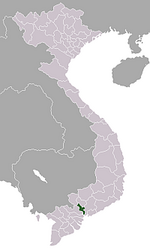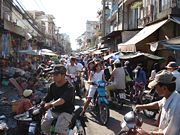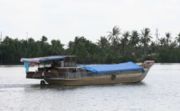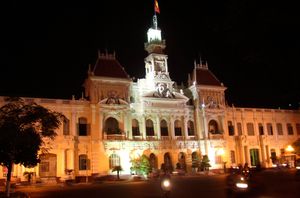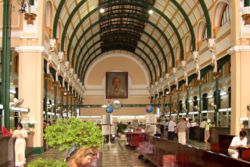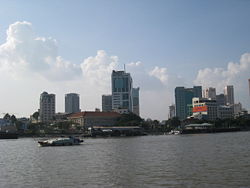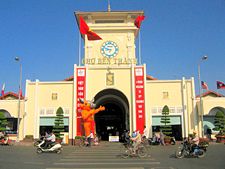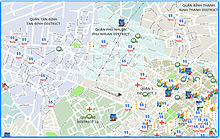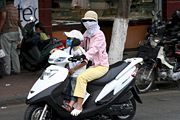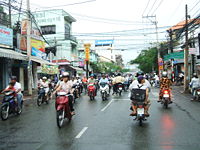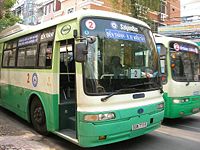Ho Chi Minh City
2008/9 Schools Wikipedia Selection. Related subjects: Asia; Asian Cities
| Ho Chi Minh City Thành Phố Hồ Chí Minh Formerly Saigon (Vietnamese: Sài Gòn) |
|
| Saigon Skyline | |
| Coordinates: | |
|---|---|
| Country | Vietnam |
| Founded | 1698 |
| Renamed | 1976 |
| Government | |
| - Type | Municipality |
| - Party Secretary | Lê Thanh Hải |
| - People's Committee Chairman: | Lê Hoàng Quân |
| - People's Council Chairwoman: | Phạm Phương Thảo |
| Area | |
| - Total | 808.9 sq mi (2,095 km²) |
| Elevation | 63 ft (19 m) |
| Population (Mid-2006) | |
| - Total | 6,424,519 |
| - Density | 7,943/sq mi (3,067/km²) |
| Area code(s) | +84 (8) |
| Website: http://www.hochiminhcity.gov.vn/ | |
Ho Chi Minh City ( Vietnamese: Thành phố Hồ Chí Minh pronunciation ) is the largest city in Vietnam and is located near the Mekong Delta. Under the name, Prey Nokor ( Khmer: ![]() ), it was the main port of Cambodia, before being annexed by the Vietnamese in the 17th century. Under the name Saigon (Vietnamese: Sài Gòn; pronunciation ), it was the capital of the French colony of Cochinchina, and later of the independent state of South Vietnam from 1954 to 1975. In 1975, Saigon was merged with the surrounding province of Gia Định and renamed Hồ Chí Minh City (although the name Sài Gòn is still commonly used.)
), it was the main port of Cambodia, before being annexed by the Vietnamese in the 17th century. Under the name Saigon (Vietnamese: Sài Gòn; pronunciation ), it was the capital of the French colony of Cochinchina, and later of the independent state of South Vietnam from 1954 to 1975. In 1975, Saigon was merged with the surrounding province of Gia Định and renamed Hồ Chí Minh City (although the name Sài Gòn is still commonly used.)
The city centre is situated on the banks of the Saigon River, 60 kilometers (37 mi) from the South China Sea and 1,760 kilometers (1,094 mi) south of Hanoi, the capital of Vietnam.
The metropolitan area, which consists of Hồ Chí Minh City metro area, Thủ Dầu Một, Di An, Bien Hoa and surrounding towns, has more than 9 million people, making it the largest metropolitan area in Vietnam and Indochina. The Greater Ho Chi Minh City Metropolitan Area, a metropolitan area covering most part of Dong Nam Bo plus Tien Giang and Long An provinces under planning will have an area of 30,000 square kilometers with a population of 20 million inhabitants by 2020.
Origin of the name
Original Khmer name
The city was known by its original Khmer inhabitants as Prey Nokor (![]() ). Prey Nokor means “forest”, or “wood” in Khmer (Prey = “forest”; Nokor = “empire,city”, from Sanskrit nagara).
). Prey Nokor means “forest”, or “wood” in Khmer (Prey = “forest”; Nokor = “empire,city”, from Sanskrit nagara).
The name Prey Nokor is still the name used in Cambodia as of 2007, as well as the name used by the Khmer Krom minority living in the delta of the Mekong.
Dr. Keng, Vansak, a famous French-educated Cambodian currently living in France, describes that the original word of Prey Nokor is Prey Kor. Prey means Forest (all Cambodian people recognize the word Prey as Forest only, not God) and Kor is a kind of tree that its fruits can be produced cotton product. Prey Kor became Prey Nokor because the Khmer ethnic people want to refer to the place as a city; Nokor means City.
Traditional Vietnamese name
After Prey Nokor was settled by Vietnamese refugees from the north, in time it became known as Sài Gòn. There is much debate about the origins of the Vietnamese name, Sài Gòn, whose etymology is analyzed below.
It should be noted, however, that before the French colonization, the official Vietnamese name of Saigon was Gia Định ( Chữ Nôm: 嘉 定). In 1862, the French discarded this official name and adopted the name "Saigon", which had always been the popular name.
From an orthographic point of view, the Vietnamese name, Sài Gòn, is written in two words, which is the traditional convention in Vietnamese spelling. Some people, however, write the name of the city as SaiGon or Saigon in order to save space or give it a more Westernized look.
Sino-Vietnamese etymology
A frequently heard, and reasonable, explanation is that Sài is a Chinese loan word (Chinese: 柴, pronounced chái in Mandarin) meaning “firewood, lops, twigs; palisade”, while Gòn is another Chinese loan word (Chinese: 棍, pronounced gùn in Mandarin) meaning “stick, pole, bole”, and whose meaning evolved into “cotton” in Vietnamese (bông gòn, literally “cotton stick”, i.e. “cotton plant”, then shortened to gòn).
Some people say that this name originated from the many cotton plants that the Khmer people had planted around Prey Nokor, and which can still be seen at Cây Mai temple and surrounding areas..
Another explanation is that the etymological meaning “twigs” (sài) and “boles” (gòn) refers to the dense and tall forest that once existed around the city, a forest to which the Khmer name, Prey Nokor, already referred.
In Chinese, the city is referred to as 西 貢, pronounced "sai gung" in Cantonese and Xīgòng in Mandarin. This represents "Saigon" written phonetically.
Khmer etymology
Another etymology often proposed, although held now as a least likely etymology, is that “Saigon” comes from “Sai Con”, which would be the transliteration of the Khmer word, prey kor (![]() ), meaning “god or heavenly” . Nokor is a Khmer word of Sanskrit origin meaning "city, land").
), meaning “god or heavenly” . Nokor is a Khmer word of Sanskrit origin meaning "city, land").
This Khmer etymology theory is quite interesting given the Khmer context that existed when the first Vietnamese settlers arrived in the region. However, it fails to completely explain how Khmer "prey" led to Vietnamese "Sài", since these two syllables appear phonetically quite distinct and as the least reasonable and least likely candidate from the khmer etymology.
Cantonese etymology
Another reasonable etymology was offered by Vương Hồng Sển, a Vietnamese scholar in the early 20th century, who asserted that Sài Gòn had its origins in the Cantonese name of Cholon (Vietnamese: quoc ngu Chợ Lớn; chu nom ![]() ) , the Chinese district of Saigon. The Cantonese (and original) name of Cholon is "Tai-Ngon" ( 堤 岸), which means "embankment" (French: quais). The theory posits that "Sài Gòn" derives from "Tai-Ngon".
) , the Chinese district of Saigon. The Cantonese (and original) name of Cholon is "Tai-Ngon" ( 堤 岸), which means "embankment" (French: quais). The theory posits that "Sài Gòn" derives from "Tai-Ngon".
Current Vietnamese name
Immediately after the communist takeover of South Vietnam in 1975, a provisional government renamed the city after Ho Chi Minh, a former North Vietnamese leader. The official name is now Thành phố Hồ Chí Minh, abbreviated Tp. HCM. This is translated as Ho Chi Minh City and abbreviated HCMC. Sài Gòn is still the most common way to refer to the city in conversation. Sài Gòn is used officially to refer to District 1, for example in bus destinations. The name is also found in company names, book titles and even on airport departure boards (the code for Tan Son Nhat International Airport is SGN).
History
Early history
Ho Chi Minh City began as a small fishing village known as Prey Nokor. The area that the city now occupies was originally swampland, and was inhabited by Khmer people for centuries before the arrival of the Vietnamese. It should be noted that in Khmer folklore that Southern Vietnam was given to the Vietnamese government as a dowry for the marriage of a Vietnamese princess to a Khmer prince in order to stop constant invasions and pillaging of Khmer villages.
Khmer rule
In 1623, King Chey Chettha II of Cambodia (1618-1628) allowed Vietnamese refugees fleeing the Trinh-Nguyen civil war in Vietnam to settle in the area of Prey Nokor, and to set up a custom house at Prey Nokor. Increasing waves of Vietnamese settlers, which the Cambodian kingdom, weakened because of war with Thailand, could not impede, slowly Vietnamized the area. In time, Prey Nokor became known as Saigon.
Nguyen dynasty rule
In 1698, Nguyen Huu Canh, a Vietnamese noble, was sent by the Nguyen rulers of Huế to establish Vietnamese administrative structures in the area, thus detaching the area from Cambodia, which was not strong enough to intervene. He is often credited with the expansion of Saigon into a significant settlement. A large Vauban citadel called Gia Dinh was built, which was later destroyed by the French over the Battle of Chi Hoa.
Colonial French era
Conquered by France in 1859, the city was influenced by the French during their colonial occupation of Vietnam, and a number of classical Western-style buildings in the city reflect this, so much so that Saigon was called "the Pearl of the Far East" (Hòn ngọc Viễn Đông) or "Paris in the Orient" (Paris Phương Đông).
Capital of South Vietnam
Former Emperor Bảo Đại made Saigon the capital of the State of Vietnam in 1950 with himself as head of state. After the Vietminh gained control of North Vietnam in 1955, the Saigon government was renamed the Republic of Vietnam, commonly referred to as South Vietnam. Saigon and Cholon, a adjacent city with many Sino-Vietnamese residents, were combined into an administrative unit called Đô Thành Sài Gòn ("Capital City Saigon").
Post-Vietnam War and today
At the conclusion of the Vietnam War, on April 30, 1975, the city came under the control of the Vietnam People's Army. In the U.S. this event is commonly called the " Fall of Saigon," while the communist Socialist Republic of Vietnam call it the "Liberation of Saigon."
In 1976, upon the establishment of the unified communist Socialist Republic of Vietnam, the city of Saigon (including Cholon), the province of Gia Ðịnh and 2 suburban districts of two other nearby provinces were combined to create Hồ Chí Minh City in honour of the late communist leader Hồ Chí Minh. The former name Saigon is still widely used by many Vietnamese, especially in informal contexts.. Generally, the term Saigon refers only to the urban districts of Hồ Chí Minh City. The word "Saigon" can also be found on shop signs all over the country, even in Hanoi.
Points of interest
Today, the city's core is still adorned with wide elegant boulevards and historic French colonial buildings. The most prominent structures in the city centre are Reunification Palace (Dinh Thống Nhất), City Hall (Uy ban Nhan dan Thanh pho), City Theatre (Nha hat Thanh pho), City Post Office (Buu dien Thanh pho), State Bank Office (Ngan hang Nha nuoc), City People's Court (Toa an Nhan dan Thanh pho) and Notre-Dame Cathedral (Nhà thờ Đức Bà). One of the oldest hotels dating from the French colonial era is the Hotel Majestic.
The city has various museums, such as the Ho Chi Minh City Museum, Museum of Vietnamese History and concerning modern history the Revolutionary Museum (Bao tang Cach mang) and the War Remnants Museum (Ho Chi Minh City).
Population
Ho Chi Minh City is home to a well-established ethnic Chinese population. Cholon, which is made up of District 5 and parts of Districts 6, 10 and 11, serves as its Chinatown.
With a population now exceeding 7 million (registered residents plus migrant workers as well as a metropolitan population of 10 million), Ho Chi Minh City is in need of vast increase in public infrastructure. To meet this need, the city and central governments have embarked on an effort to develop new urban centers. The two most prominent projects are the Thu Thiem city centre in District 2 and the Phu My Hung New City Centre in District 7 (as part of the Saigon South project) where various international schools such as Saigon South International (The American School), the Japanese school, Australia's Royal Melbourne Institute of Technology, the Taiwan and Korea schools are located).
Geography and climate
Ho Chi Minh City is located at 10°45'N, 106°40'E in the southeastern region of Vietnam, 1,760 km (1,094 miles) south of Hanoi. The average elevation is 19 meters (63 ft) above sea level. It borders Tay Ninh and Binh Duong provinces to the north, Dong Nai and Ba Ria-Vung Tau provinces to the east, Long An Province to the west and the South China Sea to the south with a coast of 15 km in length. The city covers an area of 2,095 km² (809 sq mi) (0.63% of the surface of Vietnam), extending up to Cu Chi (12mi/20 km from the Cambodian border), and down to Can Gio on the East Sea coast. The distance from the northernmost point (Phu My Hung Commune, Cu Chi District) to the southernmost one (Long Hoa Commune, Can Gio District) is 102 kilometers (63 mi), and from the easternmost point (Long Binh Ward, District Nine) to the westernmost one (Binh Chanh Commune, Binh Chanh District) is 47 kilometers (29 mi).
The city has a tropical climate, with an average humidity of 75%. A year is divided into two distinct seasons. The rainy season, with an average rainfall of about 1,800 millimetres (71 in) annually (about 150 rainy days per year), usually begins in May and ends in late November. The dry season lasts from December to April. The average temperature is 28 °C (82 °F), the highest temperature sometimes reaches 39 °C (102 °F) around noon in late April, while the lowest may fall below 16 °C (61 °F) in the early mornings of late December.
| Weather averages for Ho Chi Minh City | |||||||||||||
|---|---|---|---|---|---|---|---|---|---|---|---|---|---|
| Month | Jan | Feb | Mar | Apr | May | Jun | Jul | Aug | Sep | Oct | Nov | Dec | |
| Average high °C (°F) | 32 (90) | 33 (91) | 34 (93) | 34 (93) | 33 (91) | 32 (90) | 31 (88) | 32 (90) | 31 (88) | 31 (88) | 30 (86) | 31 (88) | |
| Average low °C (°F) | 21 (70) | 22 (72) | 23 (73) | 24 (75) | 25 (77) | 24 (75) | 25 (77) | 24 (75) | 23 (73) | 23 (73) | 22 (72) | 22 (72) | |
| Precipitation mm (inches) | 14 (0.55) | 4 (0.16) | 12 (0.47) | 42 (1.65) | 220 (8.66) | 331 (13.03) | 313 (12.32) | 267 (10.51) | 334 (13.15) | 268 (10.55) | 115 (4.53) | 56 (2.2) | |
| Source: Embassy of Vietnam, London 2008-02-26 | |||||||||||||
Political and administrative system
Ho Chi Minh City is a municipality at the same level as Vietnam's provinces. The legislative branch is called the People's Council and consists of 95 deputies. The executive is called the People's Committee and has 13 members. Real power rests with the Communist Party, led by a party secretary. The chairman of the People's Committee is typical No. 2 in the city government and the chairman of the People's Council No. 3.
The city has been divided into twenty-four administrative divisions since December 2003. Five of these {Area: 1,601 km²} are designated as rural (huyện). The rural districts are Nhà Bè, Cần Giờ, Hóc Môn, Củ Chi, and Bình Chánh. A rural district consists of communes (Xã) and townships (Thị trấn). The remaining districts {Area: 494 km²} are designated urban or suburban (quận). This includes districts one to twelve, as well as Tân Bình, Bình Thạnh, Phú Nhuận, Thủ Đức, Bình Tân, Tân Phú and Gò Vấp. Each quận is sub-divided into wards ("Phường"). Since December 2006, the city has had 259 wards, 58 communes and 5 townships (see List of HCMC administrative units below).
| List of HCMC Administrative Units | ||||||
|---|---|---|---|---|---|---|
| Name of district (since December 2003) | Sub-division units (since December 2006) | Area (km²) (since December 2006) | Population as of the October 1, 2004 Census | Population as of Mid 2005 | Population as of Mid 2006 | |
| Inner Districts: | ||||||
| District 1 | 10 wards | 7.73 | 198,032 | 199,899 | 200,768 | |
| District 2 | 11 wards | 49.74 | 125,136 | 126,084 | 130,189 | |
| District 3 | 14 wards | 4.92 | 201,122 | 199,297 | 199,172 | |
| District 4 | 15 wards | 4.18 | 180,548 | 185,268 | 189,948 | |
| District 5 | 15 wards | 4.27 | 170,367 | 192,157 | 191,258 | |
| District 6 | 14 wards | 7.19 | 241,379 | 243,416 | 248,820 | |
| District 7 | 10 wards | 35.69 | 159,490 | 163,608 | 176,341 | |
| District 8 | 16 wards | 19.18 | 360,722 | 366,251 | 373,086 | |
| District 9 | 13 wards | 114 | 202,948 | 207,696 | 214,345 | |
| District 10 | 15 wards | 5.72 | 235,231 | 235,370 | 238,799 | |
| District 11 | 16 wards | 5.14 | 224,785 | 225,908 | 227,220 | |
| District 12 | 11 wards | 52.78 | 290.129 | 299,306 | 306,922 | |
| Go Vap District | 16 wards | 19.74 | 452,083 | 468,468 | 496,905 | |
| Tan Binh District | 15 wards | 22.38 | 397,569 | 394,281 | 387,681 | |
| Tan Phu District | 11 wards | 16.06 | 366,399 | 372,519 | 376,855 | |
| Binh Thanh District | 20 wards | 20.76 | 423,896 | 435,300 | 449,943 | |
| Phu Nhuan District | 15 wards | 4.88 | 175,293 | 175,716 | 175,825 | |
| Thu Duc District | 12 wards | 47.76 | 336,571 | 346,329 | 356,088 | |
| Binh Tan District | 10 wards | 51.89 | 398,712 | 403,643 | 447,173 | |
| Total Inner Districts | 259 wards | 494.01 | 5,140,412 | 5,240,516 | 5,387,338 | |
| Suburban Districts: | ||||||
| Cu Chi District | 20 communes and 1 township | 434.50 | 288,279 | 296,032 | 309,648 | |
| Hoc Mon District | 11 communes and 1 township | 109.18 | 245,381 | 251,812 | 254,598 | |
| Binh Chanh District | 15 communes and 1 township | 252.69 | 304,168 | 311,702 | 330,605 | |
| Nha Be District | 6 communes and 1 township | 100.41 | 72,740 | 73,432 | 74,945 | |
| Can Gio District | 6 communes and 1 township | 704.22 | 66,272 | 66,444 | 67,385 | |
| Total Suburban Districts | 58 communes and 5 townships | 1,601 | 976,839 | 999,422 | 1,037,181 | |
| Whole City | 259 wards, 58 communes and 5 townships | 2,095.01 | 6,117,251 | 6,239,938 | 6,424,519 | |
Demographics
The population of Ho Chi Minh City, as of the October 1, 2004 Census, was 6,117,251 (of which 19 inner districts had 5,140,412 residents and 5 suburban districts had 976,839 inhabitants).. In the middle of 2006 the city's population was estimated to be 6,424,519 (of which 19 inner districts had 5,387,338 residents and 5 suburban districts had 1,037,181 inhabitants), or about 7.4% of the total population of Vietnam; making it the highest population-concentrated city in the country. As an administrative unit, its population is also the largest at the provincial level. As the largest economic and financial hub of Vietnam, HCMC has attracted more and more immigrants from other Vietnamese provinces in recent years; therefore, its population is growing rapidly. From 1999 - 2004, the city population has increased by about 200,000 people per year.
The majority of the population are ethnic Vietnamese ( Kinh) at about 90%. Other ethnic minorities include Chinese ( Hoa) with 8%, (the largest Chinese community in Vietnam) and other minorities (Khmer, Cham, Nung, Rhade) 2%. The inhabitants of Ho Chi Minh City are usually known as "Saigonese" in English, "Saigonnais" in French and "dân Sài Gòn" in Vietnamese.
The Kinh speak Vietnamese with their respective regional accents: Southern (about 50%), Northern (30%) and Central Vietnam (20%); while the Hoa speak Cantonese, Teochew (Chaozhou), Hokkien, Hainanese and Hakka dialects of Chinese (only a few speak Mandarin Chinese). A varying degree of English is spoken especially in the tourism and commerce sectors where dealing with foreign nationals is a necessity, so English has become a de facto second language for some Saigonese.
According to some researchers the religious breakup in HCMC is as follows: Buddhism (all sects and/or including Taoism, Confucianism, Ancestor Worship) 80%, Roman Catholic 11%, Protestant 2%, others ( Cao Dai, Hoa Hao, Islam, Hinduism, Bahá'í Faith) 2%, and no religion or unknown 5%.
Economy
Ho Chi Minh City is the most important economic centre in Vietnam as it accounts for a big percentage of Vietnam's economy. Some 300,000 businesses, including many large enterprises, are involved in high-tech, electronic, processing and light industries, also in construction, building materials and agro-products. Investors are still pouring in money into the city. Total local private investment was 160,000 billion dong ($10 billion) with 18,500 newly founded companies. Investment is trended to hi-tech and services, real estate projects. Currently, the city has 15 industrial parks and export-processing zones, in addition to the Quang Trung Software Park and the Saigon Hi-Tech Park. Intel invested about 1 billion dollar factory in the city. There are 171 medium and large scale markets, tens of supermarket chains, dozens of luxury shopping malls and many modern fashion or beauty centers. There are many malls and shopping plazas developing in the city. Over 50 banks with hundreds of branches and about 20 insurance companies are situated inside the city. The first first stock exchange of Vietnam was opened in the city in 2001.
In 2007, the city's Gross Domestic Product was estimated at $14.3 billion, or about $2,180 per capita, (up 12.6 percent on 2006) and accounting for 20 percent GDP of the country. The GDP calculating Parity Purchasing Power method (PPP), attained $71.5 billion, or about $10,870 per capita (approximately 3 times higher than the country's average). The city's Industrial Product Value was $6.4 billion, equivalent to 30 percent of the whole nation. Export - Import Turnover through HCMC ports took $36 billion, or 40 percent of the national total, of which, export revenue reached $18.3 billion, accounted for 40 percent of Vietnam’s total export revenue. At 2007, Ho Chi Minh City has also contributed about 20.5 percent to the national budget's revenue annually ,.
In 2007, this city contributed 92,000 billion dong (approx. $6 billion), an increase of 30 percent compared to that of 2006. In 2007, this city served 3 million foreign tourists, made up 70 percent that of Vietnam. Total cargo transport to Ho Chi Minh City’s ports reached 50.5 million metric tonnes, nearly one-third of that in Vietnam..
Education
Higher education in Ho Chi Minh City is quite developed, concentrating about 76 universities and colleges with a total of over 380,000 students in such places as: Ho Chi Minh City National University with 41,000 students, the most important university in the Southern Region, consisting of 6 main member schools: The University of Natural Sciences (formerly Saigon College of Sciences); The University of Social Sciences and Humanities (formerly Saigon College of Letters); The University of Technology (formerly Phu Tho National Institute of Technology); The International University, Faculty of Economics and the newly-established University of Information Technology.
Some other important higher education establishments include: HCMC University of Pedagogy, University of Economics, University of Architecture, University of Medicine and Pharmacy, Nong Lam University (formerly University of Agriculture and Forestry), University of Law, University of Technical Education, University of Banking, University of Transport, University of Industry, Open University, University of Sports and Physical Education, University of Fine Art, University of Culture the Conservatory of Music, the Saigon Institute of Technology, and Open University .
The RMIT University with about 2,000 students, the unique foreign-invested higher-education unit in Vietnam at the present, was founded in 2002 by the Royal Melbourne Institute of Technology (RMIT) of Australia.
Several reputable English language schools following international curricula are located in Ho Chi Minh City as well.
Public Health
The health care system of the city is relatively developed with a chain of about 100 publicly owned hospitals or medical centers and dozens of privately owned clinics.. The 1,400 bed Chợ Rẫy Hospital, upgraded by Japanese aid and the French-sponsored Institute of Cardiology, are among the top medical facilities in Indochina. The Hoa Hao Medical Diagnosis Centre (Medic) and FV Hospital have recently attracted many clients, including foreigners, because of their good quality of service and modern equipment. Patients come from cities in nearby provinces and Cambodia as well. The hospitals with close to international standards quality include Cho Ray Hospital, the largest hospital in Ho Chi Minh City
Transportation
Tan Son Nhat International Airport, a joint civilian and military airport, is located 4 mi (6 km) north of the city center (District 1). Taxi and bus services are available for travel to and from the airport and within the city. Because of the rapid growing number of air-passengers and Tan Son Nhat Airport's proximity to the centre of the city, the Vietnamese Government has prepared to build a new international airport near Long Thanh Township, Dong Nai Province about 25 mi (40 km) to the northeast.
Ho Chi Minh city's road system is in improvable condition. Many of its streets are riddled with potholes. This is especially true of the city's numerous back streets and alleys, which are sometimes little more than dirt paths. City buses are the only public transport available, although the city is seeking financing sources for bulding metro (subway) and elevated train projects, including the Ho Chi Minh City Metro planned for completion in 2020. Recently, the number of motorcycles has increased to about 4 million. There are also over 500,000 automobiles, packing the city's arterial roads and making traffic congestion and air pollution common problems. If Beijing is "the City of Bicycles", then Ho Chi Minh City is "the Capital of Motorbikes". Motorcycle-taxi (xe ôm) is a popular means of transport and foreigners are often greeted with the cry, "Motorbike you!" Visitors should consider the city's streets as dangerous due to the motorists' lack of behaviour and the city's lack of traffic law enforcement. Drivers can be seen driving the wrong way up one-way streets, ignoring red lights, not stopping for pedestrians on marked crossings and driving on the footpaths.
The city is the terminal hub of the North South Railroad of Vietnam. Passengers can travel to Hanoi and the Chinese border, about 1,212 mi/1,950 km to the north. There are many harbours along the Saigon and Dong Nai Rivers, such as: Saigon Port, Newport, Ben nghe Port and VICT Port. They account for the annual 40 percent export-import cargo output of Vietnam.
From Ho Chi Minh City, one can travel to many places in Southern Vietnam and to Cambodia by road or waterway. The city is linked to the Central Highlands by National Highways 14 and 20, to the Central Coast and the north by National Highway 1 and to the Mekong River Delta by National Highways 1 and 50. Two expressways are being built to connect the city to Can Tho, the capital of the Mekong River Delta, and to Dau Giay Township, Dong Nai Province, 70 km to the northeast.
People's Committee
The Ho Chi Minh City People's Committee is the administrative/government organization that manages Ho Chi Minh City (formerly known as Saigon), Vietnam. Its equivalent in the U.S. context would be a city government. The "Chairman of the People's Committee" is the head of the government, and may be considered the equivalent of Mayor. The current Chairman of the Ho Chi Minh City People's Committee (2004-2009) is Mr. Le Hoang Quan. There are several Vice Chairmen and chairwomen on the committee with responsibility for various City Government Departments.
Sister cities
There are sister cities of Ho Chi Minh City:

